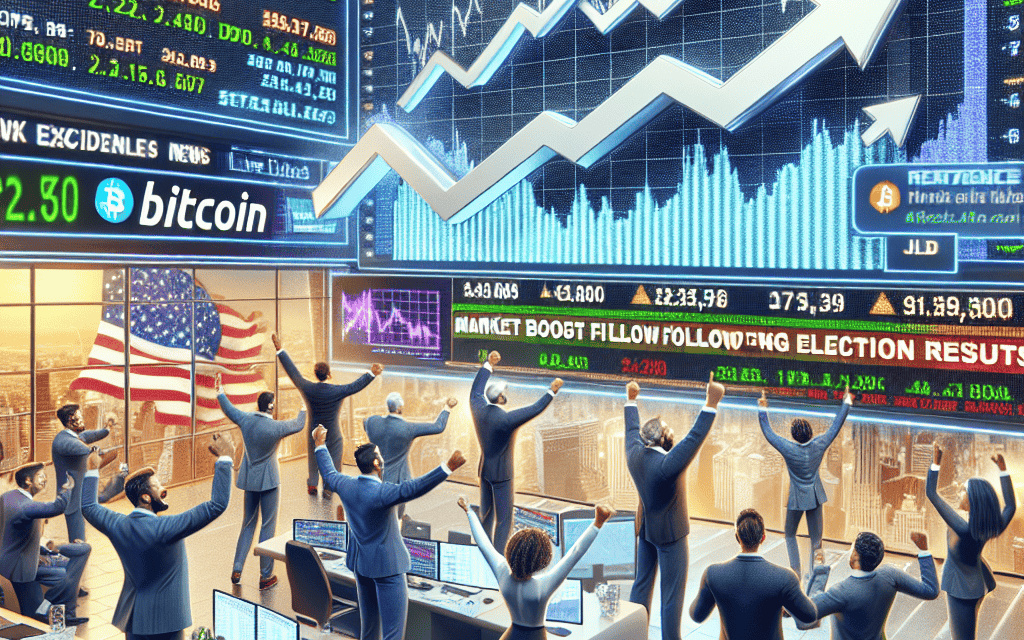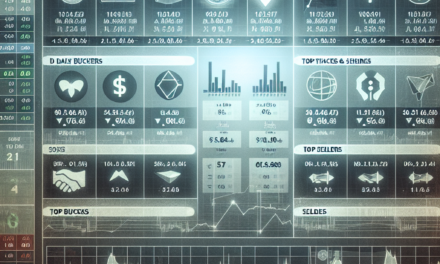“Markets Soar: Dow Futures Climb, Bitcoin Hits Record High on Trump Election Momentum”
Introduction
In a dynamic turn of events, global financial markets are experiencing a significant surge, with Dow futures climbing and Bitcoin reaching unprecedented highs. This market rally is largely attributed to the political landscape, as the election of Donald Trump has injected a wave of optimism among investors. The anticipation of pro-business policies and economic reforms under the Trump administration has fueled confidence, driving both traditional and digital asset markets to new heights. As live updates continue to unfold, market participants are closely monitoring the developments, eager to capitalize on the evolving financial landscape.
Impact Of Trump Election Boost On Global Markets
The recent surge in global markets has captured the attention of investors and analysts alike, as Dow futures rise and Bitcoin reaches unprecedented highs. This remarkable upswing is largely attributed to the so-called “Trump Election Boost,” a phenomenon that has injected a renewed sense of optimism into financial markets worldwide. As the world watches these developments unfold, it is crucial to understand the underlying factors driving this momentum and the potential implications for the global economy.
To begin with, the rise in Dow futures signifies a positive outlook among investors regarding the U.S. economy. This optimism is fueled by expectations of pro-business policies and regulatory reforms that are anticipated to follow in the wake of a Trump election boost. Historically, markets have responded favorably to the prospect of reduced corporate taxes and deregulation, which are seen as catalysts for economic growth. Consequently, the current surge in Dow futures reflects a collective belief that such policies will stimulate business investment and consumer spending, thereby bolstering economic activity.
In tandem with the rise in traditional stock markets, Bitcoin has also experienced a significant rally, reaching new all-time highs. This digital currency’s ascent can be attributed to several factors, including increased institutional interest and a growing acceptance of cryptocurrencies as a legitimate asset class. Moreover, the uncertainty surrounding traditional fiat currencies, exacerbated by geopolitical tensions and inflationary pressures, has led investors to seek alternative stores of value. Bitcoin, with its decentralized nature and limited supply, has emerged as a preferred choice for those looking to hedge against currency devaluation.
The Trump election boost has not only impacted U.S. markets but has also reverberated across global financial systems. European and Asian markets have experienced similar upward trends, as investors anticipate a ripple effect of economic growth stemming from the United States. The interconnectedness of global markets means that positive developments in one region can have far-reaching implications, fostering a sense of optimism that transcends national borders. This interconnectedness is further underscored by the role of multinational corporations, which stand to benefit from favorable trade policies and increased consumer demand.
However, it is important to approach this market exuberance with a degree of caution. While the Trump election boost has undeniably injected vitality into global markets, it also brings with it a set of challenges and uncertainties. The implementation of proposed policies may face political hurdles, and the long-term effects of such measures remain to be seen. Additionally, the rapid rise in asset prices raises concerns about potential market bubbles, which could pose risks to financial stability if left unchecked.
In conclusion, the Trump election boost has undeniably had a profound impact on global markets, as evidenced by the rise in Dow futures and Bitcoin’s new highs. This surge reflects a broader optimism about economic prospects and the potential for growth-driven policies. Nevertheless, it is essential for investors and policymakers to remain vigilant, balancing enthusiasm with prudence to ensure sustainable economic progress. As the situation continues to evolve, live updates and ongoing analysis will be crucial in navigating the complexities of this dynamic financial landscape.
Analysis Of Dow Futures Surge And Its Implications
The recent surge in the markets, marked by a significant rise in Dow futures and Bitcoin reaching new highs, has captured the attention of investors and analysts alike. This upward momentum is largely attributed to the political developments surrounding the Trump election boost, which has injected a renewed sense of optimism into the financial landscape. As we delve into the implications of this surge, it is essential to consider the various factors at play and how they might shape the future trajectory of the markets.
To begin with, the rise in Dow futures is a clear indicator of investor confidence in the economic policies anticipated under a potential Trump administration. Historically, markets have responded favorably to pro-business policies, such as tax cuts and deregulation, which are often associated with Republican leadership. The expectation of such policies being reinstated or expanded has likely fueled the current bullish sentiment. Moreover, the prospect of increased infrastructure spending and a focus on domestic manufacturing could further bolster economic growth, thereby enhancing corporate earnings and driving stock prices higher.
In tandem with the surge in Dow futures, Bitcoin has reached unprecedented levels, reflecting a broader trend of increased interest in digital assets. This rise can be attributed to several factors, including growing institutional adoption and the perception of Bitcoin as a hedge against inflation. As traditional markets experience volatility, investors are increasingly turning to cryptocurrencies as an alternative store of value. The decentralized nature of Bitcoin, coupled with its limited supply, makes it an attractive option for those seeking to diversify their portfolios and mitigate risk.
However, it is crucial to acknowledge the potential risks associated with this market exuberance. While the current optimism is palpable, it is not without its challenges. The political landscape remains highly polarized, and any unforeseen developments could quickly alter market dynamics. Additionally, the global economic recovery from the pandemic is still underway, with supply chain disruptions and inflationary pressures posing significant threats. These factors could potentially dampen the positive sentiment and lead to increased volatility in the markets.
Furthermore, the rise in Bitcoin and other cryptocurrencies has prompted regulatory scrutiny, as governments around the world grapple with how to effectively oversee this burgeoning asset class. The introduction of new regulations could impact the growth trajectory of digital currencies, creating uncertainty for investors. It is imperative for market participants to remain vigilant and adaptable in the face of these evolving circumstances.
In conclusion, the surge in Dow futures and Bitcoin’s ascent to new heights underscore the complex interplay of political, economic, and technological factors influencing the markets today. While the Trump election boost has undoubtedly contributed to the current wave of optimism, it is essential to maintain a balanced perspective and consider the potential risks that lie ahead. As the situation continues to unfold, investors and analysts must stay informed and agile, ready to navigate the challenges and opportunities that the future may hold. By doing so, they can better position themselves to capitalize on the evolving market landscape and achieve their financial objectives.
Bitcoin’s New High: Factors Driving The Cryptocurrency Market
The cryptocurrency market has been experiencing a remarkable surge, with Bitcoin reaching new all-time highs, driven by a confluence of factors that have invigorated investor interest and market dynamics. As the Dow futures rise, buoyed by optimism surrounding the Trump election boost, Bitcoin’s ascent is emblematic of the broader enthusiasm permeating financial markets. This surge in Bitcoin’s value can be attributed to several key elements that have collectively fostered a favorable environment for the cryptocurrency.
Firstly, institutional adoption has played a pivotal role in propelling Bitcoin to new heights. Over recent years, major financial institutions and corporations have increasingly embraced Bitcoin as a legitimate asset class. This institutional interest has been further amplified by the entry of prominent investment firms and hedge funds into the cryptocurrency space, which has lent credibility and stability to Bitcoin. As these entities allocate a portion of their portfolios to Bitcoin, they not only drive demand but also signal confidence in its long-term viability.
Moreover, the macroeconomic landscape has been conducive to Bitcoin’s rise. In an era marked by unprecedented monetary policy measures and fiscal stimulus, concerns about inflation and currency devaluation have intensified. Investors, seeking to hedge against these risks, have turned to Bitcoin as a store of value akin to digital gold. The decentralized nature of Bitcoin, coupled with its limited supply, has made it an attractive alternative to traditional fiat currencies, further fueling its demand.
In addition to these factors, technological advancements and regulatory developments have also contributed to Bitcoin’s upward trajectory. The maturation of blockchain technology has enhanced the security and efficiency of cryptocurrency transactions, making them more accessible to a broader audience. Concurrently, regulatory clarity in key markets has alleviated some of the uncertainties that previously hindered widespread adoption. As governments and regulatory bodies establish frameworks for cryptocurrency operations, investor confidence is bolstered, paving the way for increased participation in the market.
Furthermore, the role of social media and digital platforms in shaping market sentiment cannot be understated. Influential figures and thought leaders within the cryptocurrency community have leveraged these platforms to disseminate information and insights, thereby influencing investor behavior. The viral nature of social media has accelerated the dissemination of positive news and developments, contributing to the momentum driving Bitcoin’s price surge.
While these factors have collectively propelled Bitcoin to new highs, it is important to acknowledge the inherent volatility and risks associated with the cryptocurrency market. Price fluctuations can be swift and significant, influenced by a myriad of factors ranging from regulatory announcements to technological disruptions. Therefore, investors are advised to exercise caution and conduct thorough research before making investment decisions.
In conclusion, Bitcoin’s recent ascent to new all-time highs is the result of a complex interplay of institutional adoption, macroeconomic conditions, technological advancements, regulatory developments, and social media influence. As the cryptocurrency market continues to evolve, these factors will likely remain integral to its trajectory. However, the inherent volatility of the market necessitates a prudent approach for investors seeking to capitalize on its potential. As Bitcoin continues to capture the attention of the financial world, its journey will undoubtedly be closely watched by both enthusiasts and skeptics alike.
Comparing Traditional Markets And Cryptocurrency Trends

In recent times, the financial landscape has witnessed a remarkable convergence of traditional markets and the burgeoning cryptocurrency sector, with both experiencing significant surges. This phenomenon is particularly evident as Dow futures rise and Bitcoin reaches new highs, driven in part by the political developments surrounding the Trump election boost. The interplay between these two financial realms offers a fascinating glimpse into the evolving dynamics of global markets.
To begin with, the traditional stock market, represented by indices such as the Dow Jones Industrial Average, has long been a barometer of economic health and investor sentiment. The recent rise in Dow futures can be attributed to a confluence of factors, including positive economic indicators, corporate earnings reports, and geopolitical developments. The Trump election boost, in particular, has injected a sense of optimism among investors, who anticipate favorable policies that could stimulate economic growth. This optimism is reflected in the upward trajectory of stock prices, as market participants position themselves to capitalize on potential opportunities.
In parallel, the cryptocurrency market, led by Bitcoin, has been experiencing its own surge. Bitcoin’s ascent to new highs is emblematic of the growing acceptance and adoption of digital currencies as a legitimate asset class. The decentralized nature of cryptocurrencies, coupled with their potential for high returns, has attracted a diverse array of investors, ranging from institutional players to individual enthusiasts. The recent rally in Bitcoin can be attributed to several factors, including increased institutional interest, regulatory developments, and macroeconomic trends such as inflation concerns. As traditional financial institutions begin to embrace cryptocurrencies, the line between conventional and digital assets continues to blur.
Despite their distinct characteristics, traditional markets and cryptocurrencies share certain commonalities that have contributed to their recent upward momentum. Both are influenced by macroeconomic factors, such as monetary policy and fiscal stimulus measures, which can drive investor behavior and market trends. Additionally, technological advancements and innovations play a crucial role in shaping the trajectory of both sectors. For instance, the rise of fintech and blockchain technology has facilitated greater accessibility and efficiency in financial transactions, thereby enhancing market participation and liquidity.
However, it is important to recognize the inherent differences between these two markets. Traditional markets are typically characterized by established regulatory frameworks and a long history of operation, which provide a level of stability and predictability. In contrast, the cryptocurrency market is relatively nascent and often subject to volatility and regulatory uncertainty. This divergence in market dynamics necessitates a nuanced approach to investment strategies, as investors must navigate the unique risks and opportunities presented by each sector.
As we continue to monitor the live updates of market movements, it becomes increasingly clear that the interplay between traditional markets and cryptocurrencies is reshaping the financial landscape. The convergence of these two realms presents both challenges and opportunities for investors, policymakers, and market participants alike. By understanding the underlying drivers and trends, stakeholders can better position themselves to navigate this evolving landscape and harness the potential benefits of a diversified investment approach.
In conclusion, the recent surge in both traditional markets and cryptocurrencies underscores the dynamic nature of global finance. As Dow futures rise and Bitcoin reaches new highs, driven by factors such as the Trump election boost, it is evident that the financial world is undergoing a transformative shift. By examining the interplay between these markets, we gain valuable insights into the future of investing and the potential for innovation in the financial sector.
Investor Sentiment: How Political Events Influence Market Movements
Investor sentiment is a crucial factor in the financial markets, often swaying the direction of stocks, commodities, and cryptocurrencies. Political events, in particular, have a profound impact on market movements, as they can alter economic policies, regulatory environments, and investor confidence. The recent surge in markets, highlighted by the rise in Dow futures and Bitcoin reaching a new high, underscores the influence of political developments, specifically the boost from the Trump election. This phenomenon illustrates how political landscapes can shape investor behavior and market trajectories.
To begin with, political events can create a sense of uncertainty or optimism among investors, depending on the anticipated outcomes. In the case of the Trump election boost, investors are reacting to the potential for policy changes that could favor economic growth. Historically, Trump’s administration has been associated with deregulation and tax cuts, which are generally perceived as positive for businesses. Consequently, the anticipation of similar policies has led to increased investor confidence, driving up the Dow futures as market participants expect a favorable business environment.
Moreover, the impact of political events is not confined to traditional markets alone. Cryptocurrencies, such as Bitcoin, are also influenced by political developments. The recent surge in Bitcoin’s value can be attributed to a combination of factors, including the perception of Bitcoin as a hedge against political and economic instability. As traditional markets react to political events, investors often seek alternative assets to diversify their portfolios and mitigate risks. Bitcoin, with its decentralized nature, offers an attractive option for those looking to protect their investments from potential market volatility induced by political changes.
In addition to policy expectations, political events can also affect investor sentiment through changes in geopolitical dynamics. For instance, the Trump election boost may lead to shifts in international relations, trade agreements, and global economic policies. These changes can have far-reaching implications for multinational corporations and global supply chains, influencing investor decisions and market movements. As investors assess the potential impact of these geopolitical shifts, their sentiment is reflected in the buying and selling of assets, contributing to market volatility.
Furthermore, the media plays a significant role in shaping investor sentiment during political events. News coverage and analysis can amplify the perceived impact of political developments, influencing how investors interpret and react to these events. In the case of the Trump election boost, media reports highlighting potential economic benefits have likely contributed to the positive sentiment in the markets. As investors consume this information, their expectations and decisions are shaped, further driving market movements.
In conclusion, political events are a powerful force in influencing investor sentiment and market movements. The recent surge in markets, driven by the rise in Dow futures and Bitcoin reaching a new high amid the Trump election boost, exemplifies the impact of political developments on financial markets. As investors navigate the complexities of political landscapes, their sentiment is shaped by policy expectations, geopolitical dynamics, and media coverage. Understanding these influences is essential for investors seeking to make informed decisions and capitalize on market opportunities. As the political environment continues to evolve, its impact on investor sentiment and market movements will remain a critical area of focus for market participants.
The Role Of Economic Policies In Market Fluctuations
The intricate relationship between economic policies and market fluctuations is a subject of perennial interest to investors, policymakers, and economists alike. As markets surge with Dow futures rising and Bitcoin reaching new highs, particularly amid the backdrop of a Trump election boost, it becomes imperative to understand the underlying economic policies that drive such market dynamics. Economic policies, encompassing fiscal, monetary, and regulatory measures, play a pivotal role in shaping market behavior and investor sentiment. These policies can either stimulate or stifle economic growth, thereby influencing market trends.
Fiscal policy, which involves government spending and taxation, directly impacts economic activity. For instance, tax cuts can increase disposable income for consumers and businesses, potentially leading to higher spending and investment. This, in turn, can boost corporate earnings and stock prices, as evidenced by the market’s positive response to tax reforms during the Trump administration. Conversely, increased government spending on infrastructure and public services can create jobs and stimulate demand, further propelling market growth. However, it is crucial to balance such spending with fiscal responsibility to avoid excessive deficits that could lead to inflationary pressures.
Monetary policy, managed by central banks, is another critical factor influencing market fluctuations. By adjusting interest rates and controlling the money supply, central banks can either encourage borrowing and investment or curb inflationary trends. For example, lower interest rates reduce the cost of borrowing, encouraging businesses to expand and consumers to spend, thereby driving economic growth and market optimism. The recent surge in Bitcoin and other cryptocurrencies can also be partially attributed to loose monetary policies, as investors seek alternative assets in a low-interest-rate environment. However, the challenge lies in timing these policy adjustments to avoid overheating the economy or triggering a recession.
Regulatory policies also play a significant role in market dynamics. Deregulation can reduce compliance costs for businesses, fostering innovation and competition, which can lead to increased profitability and stock market gains. The Trump administration’s focus on deregulation was seen as a catalyst for market growth, as it aimed to create a more business-friendly environment. On the other hand, stringent regulations, while necessary for ensuring market stability and protecting consumers, can sometimes hinder business operations and dampen investor enthusiasm.
In addition to these domestic policies, global economic policies and geopolitical events can also influence market fluctuations. Trade policies, for instance, can have far-reaching effects on international markets. Tariffs and trade agreements can alter the competitive landscape, affecting supply chains and corporate earnings. The anticipation of policy changes, such as those associated with a potential Trump re-election, can lead to market volatility as investors adjust their portfolios in response to expected shifts in trade relations and economic priorities.
In conclusion, the interplay between economic policies and market fluctuations is complex and multifaceted. As markets experience surges, such as the recent rise in Dow futures and Bitcoin’s new highs, it is essential to consider the broader economic policy context. Understanding the impact of fiscal, monetary, and regulatory measures, along with global economic policies, provides valuable insights into market behavior. By analyzing these factors, investors and policymakers can better navigate the ever-changing economic landscape, making informed decisions that contribute to sustainable economic growth and market stability.
Future Predictions: Sustaining The Momentum In Financial Markets
The financial markets have recently experienced a significant surge, with Dow futures rising and Bitcoin reaching new highs, largely attributed to the boost from the Trump election. This remarkable upswing has prompted investors and analysts alike to ponder the sustainability of this momentum in the financial markets. As we delve into future predictions, it is essential to consider the various factors that could influence the continuation of this upward trajectory.
To begin with, the political landscape plays a crucial role in shaping market dynamics. The recent election results have instilled a sense of optimism among investors, as policies anticipated under the Trump administration are expected to favor economic growth. Tax reforms, deregulation, and infrastructure spending are among the key initiatives that could stimulate business activity and, consequently, bolster market performance. However, it is important to remain cautious, as political uncertainties and potential policy shifts could introduce volatility and impact investor confidence.
In addition to political factors, economic indicators will be pivotal in sustaining market momentum. The current economic environment, characterized by low interest rates and moderate inflation, provides a conducive backdrop for continued market growth. Central banks, particularly the Federal Reserve, are likely to maintain accommodative monetary policies to support economic recovery. This approach could further enhance liquidity in the markets, encouraging investment and driving asset prices higher. Nevertheless, any unexpected changes in monetary policy or economic conditions could pose risks to the ongoing rally.
Moreover, technological advancements and innovation continue to be significant drivers of market growth. The rapid pace of digital transformation across various sectors has opened new avenues for investment and profitability. Companies that successfully leverage technology to enhance efficiency and deliver innovative products and services are likely to attract investor interest and contribute to market gains. As such, keeping an eye on technological trends and their potential impact on different industries will be crucial for predicting future market movements.
Furthermore, the global economic landscape cannot be overlooked when assessing the sustainability of market momentum. International trade relations, geopolitical tensions, and economic performance in key regions all have the potential to influence market dynamics. A stable global environment, characterized by cooperative trade agreements and robust economic growth, would likely support continued market expansion. Conversely, escalating trade disputes or geopolitical conflicts could disrupt supply chains and dampen investor sentiment, thereby affecting market performance.
In the realm of cryptocurrencies, Bitcoin’s recent surge to new highs has captured the attention of both traditional and digital asset investors. The growing acceptance of cryptocurrencies as a legitimate asset class, coupled with increased institutional interest, has contributed to Bitcoin’s upward trajectory. However, the inherent volatility of cryptocurrencies necessitates a cautious approach. Regulatory developments, technological advancements, and market sentiment will all play a role in determining the future path of Bitcoin and other digital currencies.
In conclusion, while the current surge in financial markets is encouraging, sustaining this momentum will depend on a multitude of factors. Political stability, favorable economic conditions, technological innovation, and a stable global environment are all critical components that could influence future market performance. As investors navigate this complex landscape, maintaining a balanced perspective and staying informed about potential risks and opportunities will be essential for making informed investment decisions. By closely monitoring these factors, market participants can better position themselves to capitalize on future growth while mitigating potential challenges.
Q&A
1. **What caused the surge in the markets?**
The surge in the markets was primarily driven by optimism surrounding the election results, with investors reacting positively to the potential economic policies of a Trump administration.
2. **How did Dow Futures perform?**
Dow Futures rose significantly, indicating a strong opening for the stock market as investors anticipated favorable conditions for businesses and economic growth.
3. **What was the new high reached by Bitcoin?**
Bitcoin reached a new all-time high, driven by increased investor interest and the perception of Bitcoin as a hedge against economic uncertainty.
4. **What sectors benefited the most from the market surge?**
Financials, industrials, and energy sectors saw significant gains as investors expected deregulation and infrastructure spending under the new administration.
5. **How did international markets react?**
International markets had mixed reactions, with some experiencing gains due to the positive sentiment in the U.S., while others were cautious due to geopolitical uncertainties.
6. **What are the potential risks mentioned by analysts?**
Analysts highlighted potential risks such as policy implementation challenges, geopolitical tensions, and the possibility of market volatility due to rapid changes in investor sentiment.
7. **What impact did the election have on investor confidence?**
The election boosted investor confidence, as many believed that the new administration’s policies would stimulate economic growth and corporate profitability.
Conclusion
The recent surge in markets, highlighted by the rise in Dow futures and Bitcoin reaching a new high, can be attributed to the positive sentiment surrounding the election boost for Trump. This development has instilled confidence among investors, leading to increased market activity and optimism. The rally in traditional markets, alongside the performance of cryptocurrencies like Bitcoin, reflects a broader trend of risk-on sentiment as investors anticipate favorable economic policies and stability. However, while the immediate reaction is positive, it remains essential to monitor ongoing political developments and their potential long-term impacts on market dynamics.





